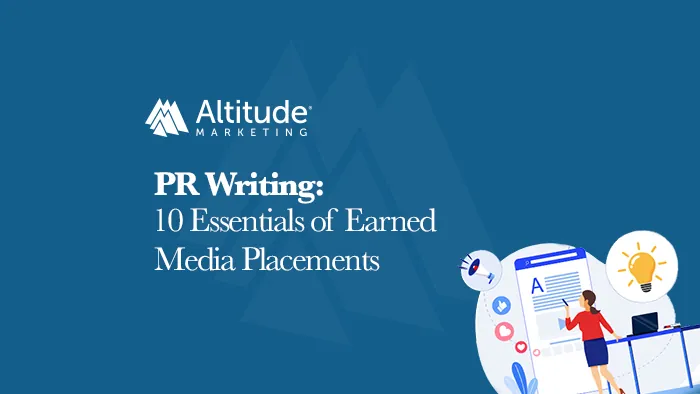Note: This blog was updated October 2024.
Writing a post for your B2B website to contribute to SEO performance is one thing. PR writing – trying to earn a placement – is an entirely different one. Let’s see how it’s done.

B2B PR Writing: 10 Ways to Land More Pitches
B2B PR Writing vs. B2B SEO Writing
B2B PR writing is much more than writing a press release. The business-to-business public relations bucket includes press releases, pitches, editor relations, communication plans and articles for publication. For the sake of this blog, we’re classifying B2B PR writing as the actual development of an earned media placement.
So, how is PR writing different from SEO writing?
Yes, you should be writing to a real person for both types. But the foundation of SEO writing is appealing to Google, while the foundation of PR writing is appealing to editors and their readers.
Frankly put, Google is a lot less picky than editors. This is not to say that blogs are written poorly, but the overall tone and structure of an SEO blog is a lot more forgiving than a PR article.
PR writing requires its own set of rules. What works for search engine optimization may not work for PR writing because the goal of each type of content is different. SEO is about raising organic traffic. PR is about raising brand awareness and thought leadership.
So, if you’re planning on repurposing a blog into an article for publication (which can definitely be done), you’ll probably have to rework a lot of it to appeal to the publication’s readership (but more on that later).
Whether you’re writing from scratch or reworking existing content, here are 10 essential elements to keep in mind as you put together an earned media placement.

10 Essential Elements of B2B PR Writing
#1. Figure out your pitch
Before you can write an article for an earned media placement, you have to do just that: Earn it.
So, start with your pitch (or brief). In 1-2 paragraphs, you should answer these questions:
- What’s your angle?
- What do you want to say about the topic?
- What questions do you have to answer about it?
- What will people find interesting?
From here, you have a North Star – something guiding your process once your pitch is accepted.
#2. Take a step back
Well, well, well. You’ve pitched an idea to an editor at your target publication. The editor responds and wants to feature the article in an upcoming issue. You suddenly have a tight deadline and a magazine-worthy article to write.
Now what?
It’s time to put your PR writing hat on.
Which means stepping away from the keyword.
Before you start writing, think critically about what you want the article to accomplish. What do you want it to sound like? As a reader, what would you expect in an article like this? You need to understand the purpose of your endeavor so it doesn’t get lost when you write.
#3. Inform, don’t sell
Rule number one (well, three) of B2B PR writing is to inform. Don’t sell.
Take off your marketing hat and approach the topic as a curious observer. A publication’s objective is to educate, not sell your product and service. Their audience wants to catch up on industry trends, get their questions answered or weigh the positions of a specific hot topic.
Anyways, the publication will likely reject any article that sounds like a sales or marketing piece. If you’re doing B2B PR writing right, you’re elevating your brand as a thought leader – which will likely (and indirectly) lead to more awareness and leads in the future.
So, be a genuine member of your industry. After all, that’s why your solution exists in the first place: You’re passionate about solving industry problems. Show it!
#4. Read the publication
It’s important to get a sense for the kind of content the publication publishes so you can fit into the overall style.
Pay attention to the tone, formatting, length and readability of other articles.
Also, reading the publication before you even make a pitch is helpful, too. What type of articles do they publish? Purely educational, or are there articles that take a position? This will help inform your topic and point of view.
#5. Find outside opinions
What are other people saying about your topic or concept?
You want to come to the table with something new – or something that opposes the norm. Find other sources to uncover these opposing opinions. This background will help make your angle or argument stronger.
#6. Talk to the SMEs
Editors want experts. So, consult a subject matter expert at your company. SMEs have valuable experience and information that will be genuinely useful to readers.
They can also talk in detail about specific topics – saving you time from background research.
#7. Article & paragraph length
A typical public relations article usually falls within 750 and 1,500 words.
Also, articles usually include full-length paragraphs. This is another key difference between a blog and PR article. Blogs, as you can probably guess by now, typically have short, punchy paragraphs.
Longer paragraphs make the PR article look more authoritative and formal, establishing expertise and even trustworthiness.
However, don’t sacrifice readability for big blocks of text. You still want to make it easy for your reader to get through. Follow regular writing and grammar guidelines, but know that you can be a little more robust.
#8. Conclude the article
Like every piece of good content, PR articles need a closing.
But this doesn’t mean a call-to-action. Remember: This isn’t a blog and you’re not selling.
What this does mean is one or two paragraphs that wrap everything up. What point are you trying to make in the article? What does it all signify? What new idea or perspective do you want your reader to walk away with?
#9. Reference outside resources
In PR writing, it’s always a good idea to include outside resources. This further bolsters your authority because it shows you’re taking into account more information beyond your central argument (see #5). These references can be as simple as hyperlinks within the text (for online publications) or citations at the end.
If the publication allows, you can add a hyperlink to your company. If the topic is very comprehensive, don’t be afraid to link to one of your blogs on the topic, too (again, as long as it’s okay with the publication).
#10. Add images
Many publications will ask for 1-3 images to accompany your article. If this is the case, try to avoid stock photos. The more specific and technical, the better.
Ultimately, images should help tell the story. So, don’t be redundant with imagery. If it adds no unique value to the article, cut it.
B2B PR Writing Element | Why It’s Important | Impact |
1. Figure out your pitch | Guides the angle, questions, and interesting points for the article. | Provides a North Star for the writing process. |
2. Take a step back | Helps understand the purpose and expected tone of the article. | Prevents the writing from sounding like a marketing piece. |
3. Inform, don’t sell | Publications aim to educate, not promote products/services. | Establishes thought leadership without direct selling. |
4. Read the publication | Understand the style, tone, formatting, and typical article types. | Ensures the article fits the publication’s overall voice and content. |
5. Find outside opinions | Uncovers opposing views and new perspectives on the topic. | Strengthens the article’s angle or argument. |
6. Talk to SMEs | Subject matter experts provide valuable experience and details. | Adds genuine expertise and saves time on research. |
7. Article & paragraph length | Typical PR articles are 750-1,500 words with longer paragraphs. | Conveys authority, formality, and trustworthiness. |
8. Conclude the article | Wrap up the main point, idea, or perspective. | Leaves the reader with a clear takeaway. |
9. Reference outside resources | Include hyperlinks, citations, and other external sources. | Bolsters authority and shows a well-rounded perspective. |
10. Add images | Use specific, technical images that tell the story. | Enhances the article’s narrative and value. |
Conclusion
B2B PR writing should be fun. You get to explore an important industry topic that you’re passionate about. The goal is to make a difference and spark a conversation.
So long as you approach the task from the perspective of the reader – what would you want to read as you peruse your favorite industry publication? – your article (and hopefully articles) will take you far.
FAQs
What's the difference between B2B PR writing and SEO writing?
SEO writing focuses on appealing to search engines like Google to increase website traffic. On the other hand, PR writing aims to appeal to editors and readers of publications. The goals are different – PR writing raises brand awareness and thought leadership, while SEO writing boosts organic traffic.
Why can't I just reuse my blog content for a PR article?
While repurposing blog content is possible, you’ll likely need to rework a lot of it. Blog posts are generally more casual and forgiving in tone and structure, while PR articles require a more formal and authoritative voice to fit the publication’s style.
Why shouldn't I try to sell or market in a PR article?
Publications aim to educate their readers, not promote specific products or services. A sales-y or marketing tone will likely get your article rejected. Instead, approach the topic as an industry expert providing valuable information.



